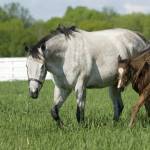Reproduction in Older Mares

Reproductive potential begins to decline in mares that are more than 15 years old. By this age, the first ovulation in the spring is typically about two weeks later than in younger mares. The interval between estrous cycles is also about four or five days longer, primarily due to slower development of follicles. Additionally, mares after this age fail to ovulate in about 13% of their estrous cycles. Use of human chorionic gonadotropin to induce ovulation becomes less effective as mares age.
Older mares have a higher incidence of pregnancy loss, possibly due to defective oocytes, changes in the intrauterine environment, or other factors. Though mares in their early forties are reported to have delivered healthy foals, estrous cycles generally become more irregular after the age of 20 until they stop completely somewhere around the age of 25 in most mares.
Many breeders feel it is especially difficult to get two groups of older mares in foal: those that have never been pregnant, and those that have not produced a live foal in the previous year. This information should be considered by owners who want a foal from a particular mare at some time in the future. Excellent nutrition, diligent health care, and special techniques such as embryo transfer or artificial insemination can boost the chances of getting an older mare in foal.








